Calculation and Allocation of Impairment Loss: A Case Study
VerifiedAdded on 2019/10/30
|9
|1594
|415
Report
AI Summary
The assignment content discusses the calculation of impairment loss for a chosen non-financial asset (CGU) and its allocation to specific assets within the CGU. The fair value, value in use, and recoverable amount are calculated to determine the impairment loss. The impairment loss is then allocated based on carrying amounts and weightage. Journal entries are also provided to record the impairment loss.
Contribute Materials
Your contribution can guide someone’s learning journey. Share your
documents today.
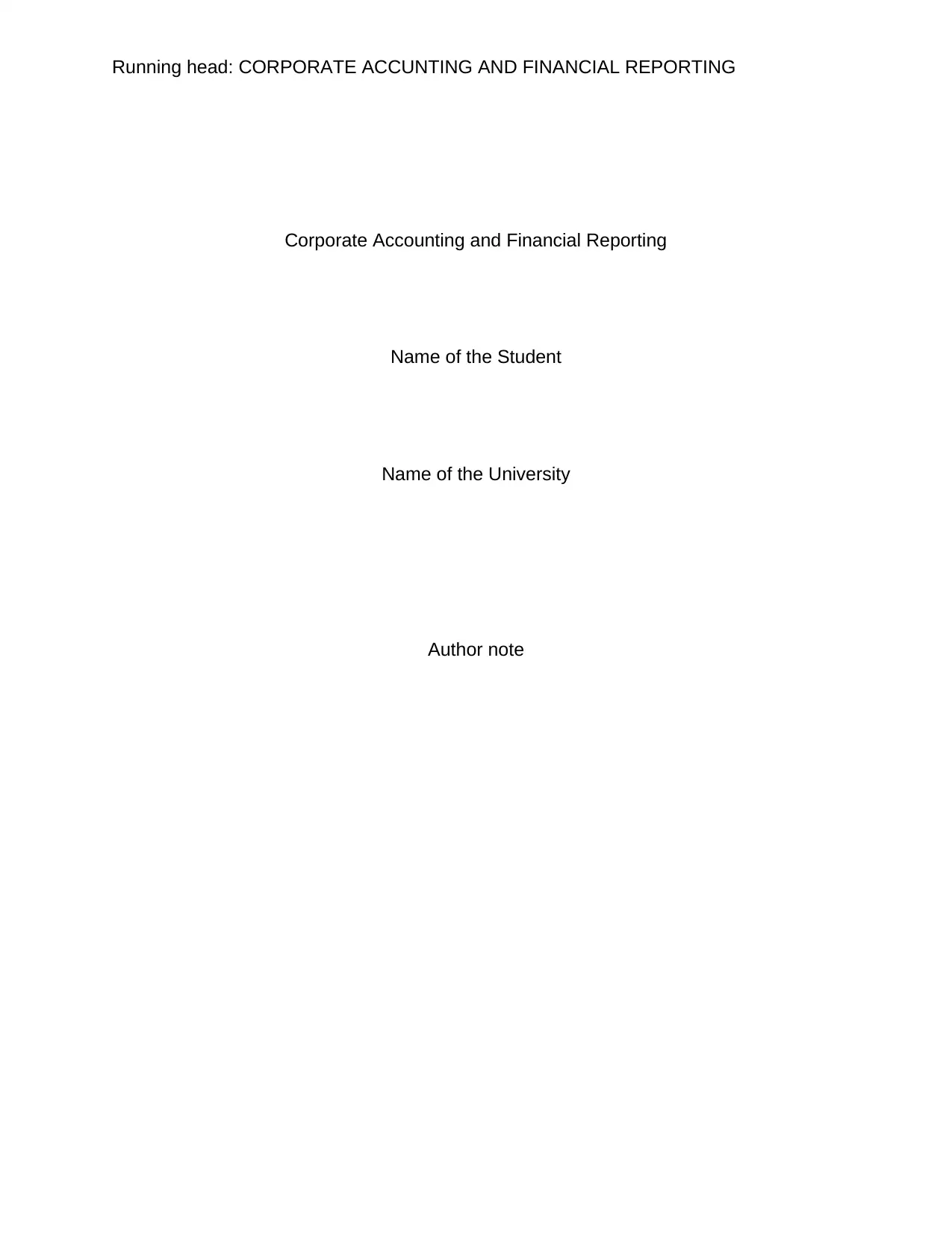
Running head: CORPORATE ACCUNTING AND FINANCIAL REPORTING
Corporate Accounting and Financial Reporting
Name of the Student
Name of the University
Author note
Corporate Accounting and Financial Reporting
Name of the Student
Name of the University
Author note
Secure Best Marks with AI Grader
Need help grading? Try our AI Grader for instant feedback on your assignments.
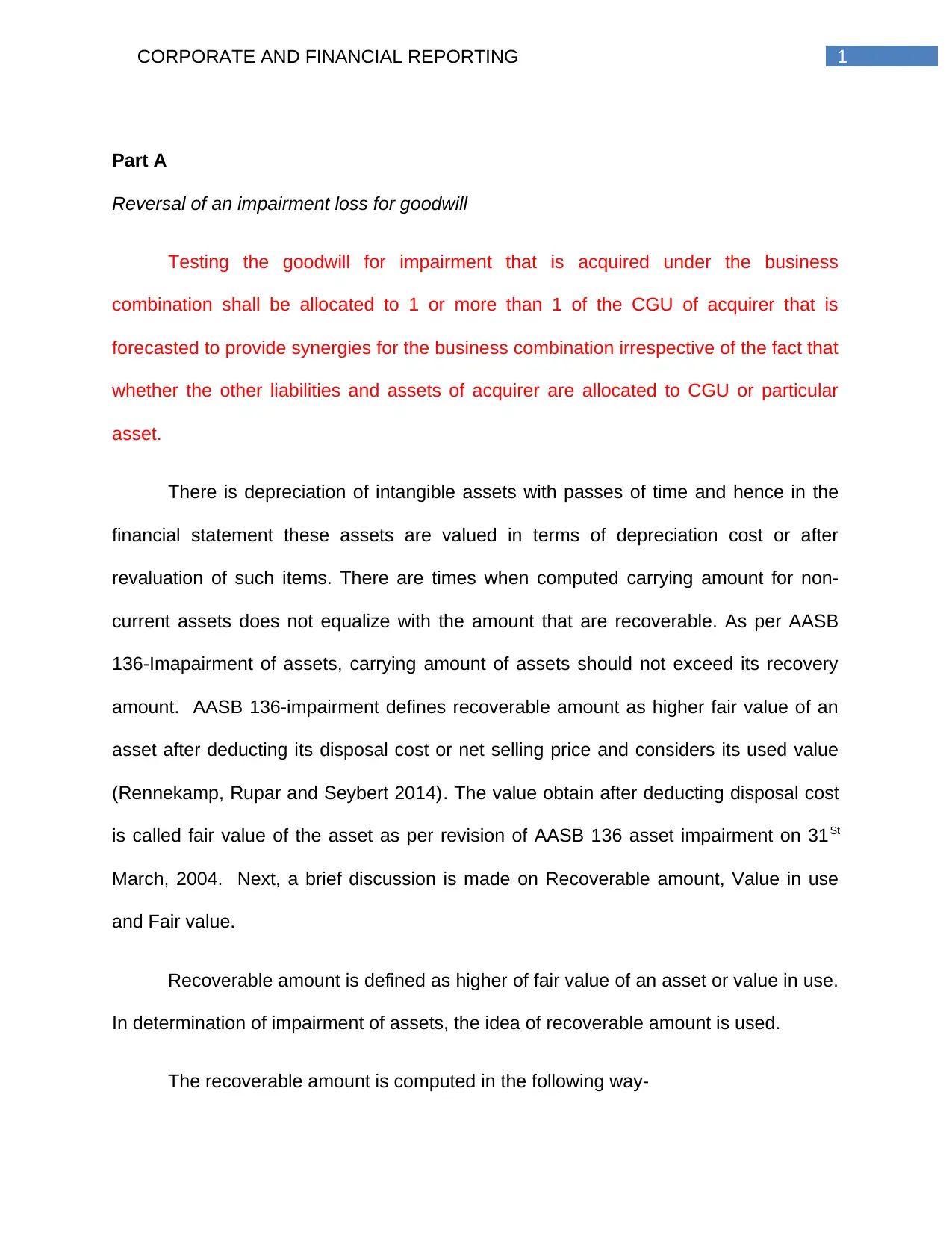
1CORPORATE AND FINANCIAL REPORTING
Part A
Reversal of an impairment loss for goodwill
Testing the goodwill for impairment that is acquired under the business
combination shall be allocated to 1 or more than 1 of the CGU of acquirer that is
forecasted to provide synergies for the business combination irrespective of the fact that
whether the other liabilities and assets of acquirer are allocated to CGU or particular
asset.
There is depreciation of intangible assets with passes of time and hence in the
financial statement these assets are valued in terms of depreciation cost or after
revaluation of such items. There are times when computed carrying amount for non-
current assets does not equalize with the amount that are recoverable. As per AASB
136-Imapairment of assets, carrying amount of assets should not exceed its recovery
amount. AASB 136-impairment defines recoverable amount as higher fair value of an
asset after deducting its disposal cost or net selling price and considers its used value
(Rennekamp, Rupar and Seybert 2014). The value obtain after deducting disposal cost
is called fair value of the asset as per revision of AASB 136 asset impairment on 31St
March, 2004. Next, a brief discussion is made on Recoverable amount, Value in use
and Fair value.
Recoverable amount is defined as higher of fair value of an asset or value in use.
In determination of impairment of assets, the idea of recoverable amount is used.
The recoverable amount is computed in the following way-
Part A
Reversal of an impairment loss for goodwill
Testing the goodwill for impairment that is acquired under the business
combination shall be allocated to 1 or more than 1 of the CGU of acquirer that is
forecasted to provide synergies for the business combination irrespective of the fact that
whether the other liabilities and assets of acquirer are allocated to CGU or particular
asset.
There is depreciation of intangible assets with passes of time and hence in the
financial statement these assets are valued in terms of depreciation cost or after
revaluation of such items. There are times when computed carrying amount for non-
current assets does not equalize with the amount that are recoverable. As per AASB
136-Imapairment of assets, carrying amount of assets should not exceed its recovery
amount. AASB 136-impairment defines recoverable amount as higher fair value of an
asset after deducting its disposal cost or net selling price and considers its used value
(Rennekamp, Rupar and Seybert 2014). The value obtain after deducting disposal cost
is called fair value of the asset as per revision of AASB 136 asset impairment on 31St
March, 2004. Next, a brief discussion is made on Recoverable amount, Value in use
and Fair value.
Recoverable amount is defined as higher of fair value of an asset or value in use.
In determination of impairment of assets, the idea of recoverable amount is used.
The recoverable amount is computed in the following way-
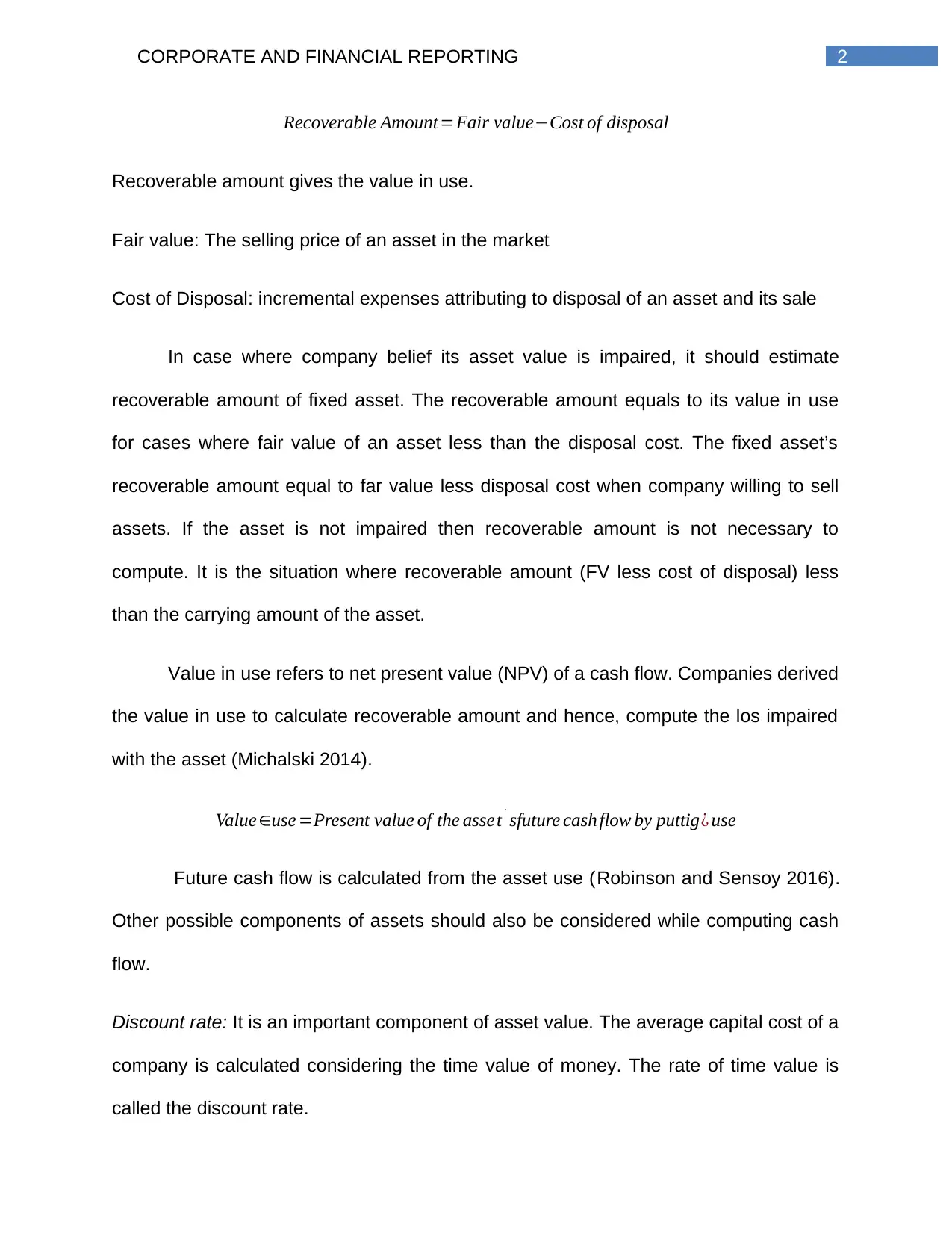
2CORPORATE AND FINANCIAL REPORTING
Recoverable Amount=Fair value−Cost of disposal
Recoverable amount gives the value in use.
Fair value: The selling price of an asset in the market
Cost of Disposal: incremental expenses attributing to disposal of an asset and its sale
In case where company belief its asset value is impaired, it should estimate
recoverable amount of fixed asset. The recoverable amount equals to its value in use
for cases where fair value of an asset less than the disposal cost. The fixed asset’s
recoverable amount equal to far value less disposal cost when company willing to sell
assets. If the asset is not impaired then recoverable amount is not necessary to
compute. It is the situation where recoverable amount (FV less cost of disposal) less
than the carrying amount of the asset.
Value in use refers to net present value (NPV) of a cash flow. Companies derived
the value in use to calculate recoverable amount and hence, compute the los impaired
with the asset (Michalski 2014).
Value∈use =Present value of the asset' sfuture cash flow by puttig¿ use
Future cash flow is calculated from the asset use (Robinson and Sensoy 2016).
Other possible components of assets should also be considered while computing cash
flow.
Discount rate: It is an important component of asset value. The average capital cost of a
company is calculated considering the time value of money. The rate of time value is
called the discount rate.
Recoverable Amount=Fair value−Cost of disposal
Recoverable amount gives the value in use.
Fair value: The selling price of an asset in the market
Cost of Disposal: incremental expenses attributing to disposal of an asset and its sale
In case where company belief its asset value is impaired, it should estimate
recoverable amount of fixed asset. The recoverable amount equals to its value in use
for cases where fair value of an asset less than the disposal cost. The fixed asset’s
recoverable amount equal to far value less disposal cost when company willing to sell
assets. If the asset is not impaired then recoverable amount is not necessary to
compute. It is the situation where recoverable amount (FV less cost of disposal) less
than the carrying amount of the asset.
Value in use refers to net present value (NPV) of a cash flow. Companies derived
the value in use to calculate recoverable amount and hence, compute the los impaired
with the asset (Michalski 2014).
Value∈use =Present value of the asset' sfuture cash flow by puttig¿ use
Future cash flow is calculated from the asset use (Robinson and Sensoy 2016).
Other possible components of assets should also be considered while computing cash
flow.
Discount rate: It is an important component of asset value. The average capital cost of a
company is calculated considering the time value of money. The rate of time value is
called the discount rate.
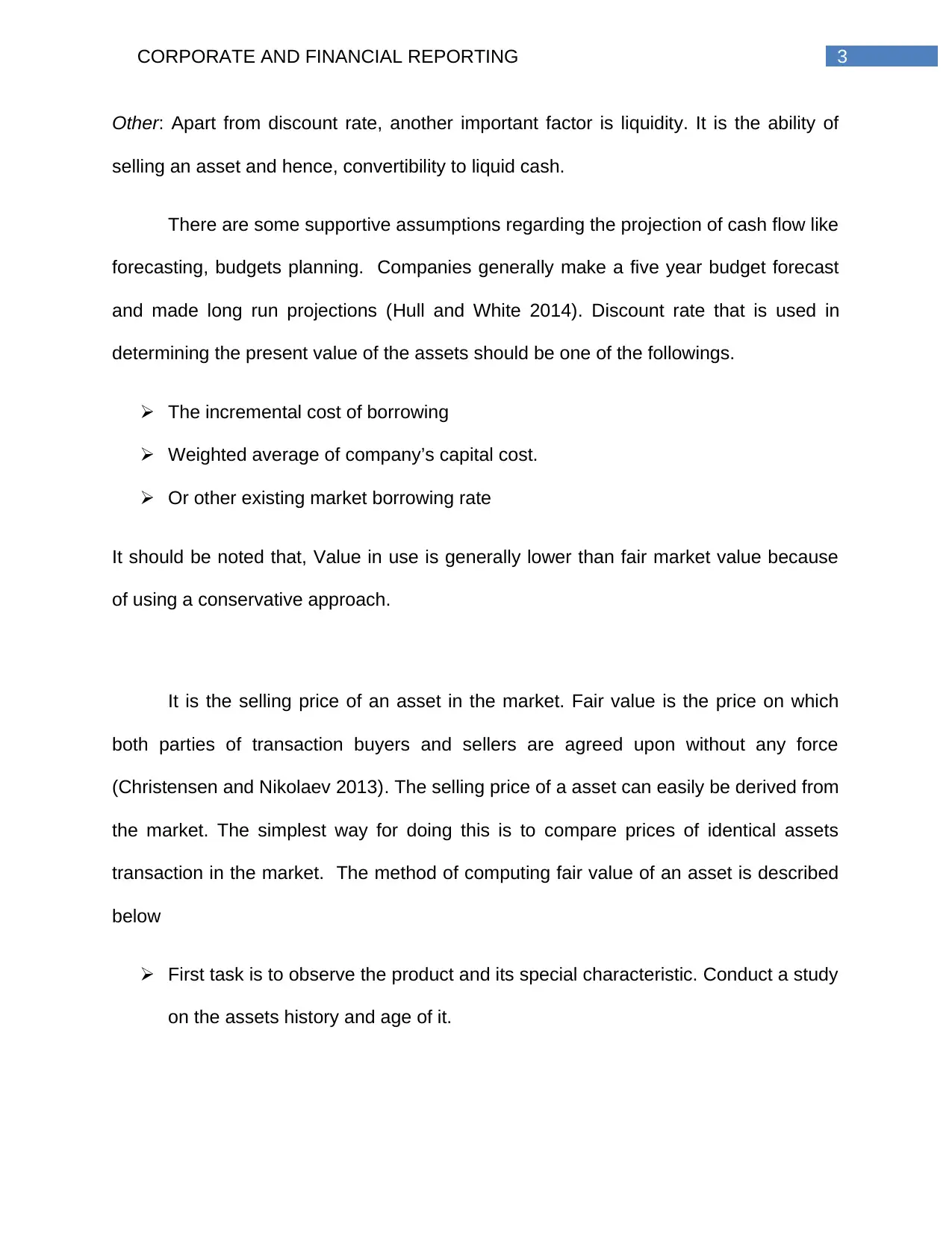
3CORPORATE AND FINANCIAL REPORTING
Other: Apart from discount rate, another important factor is liquidity. It is the ability of
selling an asset and hence, convertibility to liquid cash.
There are some supportive assumptions regarding the projection of cash flow like
forecasting, budgets planning. Companies generally make a five year budget forecast
and made long run projections (Hull and White 2014). Discount rate that is used in
determining the present value of the assets should be one of the followings.
The incremental cost of borrowing
Weighted average of company’s capital cost.
Or other existing market borrowing rate
It should be noted that, Value in use is generally lower than fair market value because
of using a conservative approach.
It is the selling price of an asset in the market. Fair value is the price on which
both parties of transaction buyers and sellers are agreed upon without any force
(Christensen and Nikolaev 2013). The selling price of a asset can easily be derived from
the market. The simplest way for doing this is to compare prices of identical assets
transaction in the market. The method of computing fair value of an asset is described
below
First task is to observe the product and its special characteristic. Conduct a study
on the assets history and age of it.
Other: Apart from discount rate, another important factor is liquidity. It is the ability of
selling an asset and hence, convertibility to liquid cash.
There are some supportive assumptions regarding the projection of cash flow like
forecasting, budgets planning. Companies generally make a five year budget forecast
and made long run projections (Hull and White 2014). Discount rate that is used in
determining the present value of the assets should be one of the followings.
The incremental cost of borrowing
Weighted average of company’s capital cost.
Or other existing market borrowing rate
It should be noted that, Value in use is generally lower than fair market value because
of using a conservative approach.
It is the selling price of an asset in the market. Fair value is the price on which
both parties of transaction buyers and sellers are agreed upon without any force
(Christensen and Nikolaev 2013). The selling price of a asset can easily be derived from
the market. The simplest way for doing this is to compare prices of identical assets
transaction in the market. The method of computing fair value of an asset is described
below
First task is to observe the product and its special characteristic. Conduct a study
on the assets history and age of it.
Secure Best Marks with AI Grader
Need help grading? Try our AI Grader for instant feedback on your assignments.
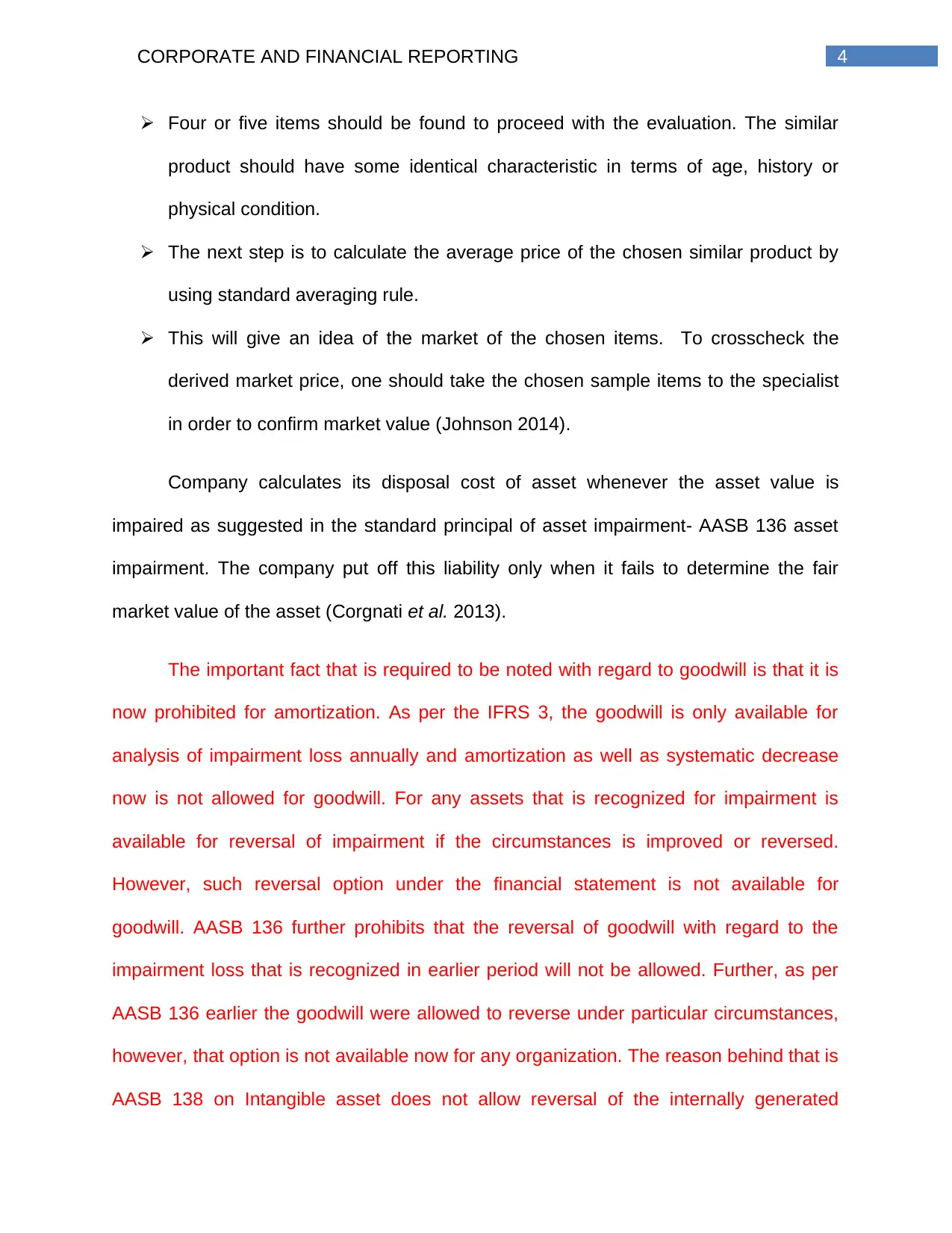
4CORPORATE AND FINANCIAL REPORTING
Four or five items should be found to proceed with the evaluation. The similar
product should have some identical characteristic in terms of age, history or
physical condition.
The next step is to calculate the average price of the chosen similar product by
using standard averaging rule.
This will give an idea of the market of the chosen items. To crosscheck the
derived market price, one should take the chosen sample items to the specialist
in order to confirm market value (Johnson 2014).
Company calculates its disposal cost of asset whenever the asset value is
impaired as suggested in the standard principal of asset impairment- AASB 136 asset
impairment. The company put off this liability only when it fails to determine the fair
market value of the asset (Corgnati et al. 2013).
The important fact that is required to be noted with regard to goodwill is that it is
now prohibited for amortization. As per the IFRS 3, the goodwill is only available for
analysis of impairment loss annually and amortization as well as systematic decrease
now is not allowed for goodwill. For any assets that is recognized for impairment is
available for reversal of impairment if the circumstances is improved or reversed.
However, such reversal option under the financial statement is not available for
goodwill. AASB 136 further prohibits that the reversal of goodwill with regard to the
impairment loss that is recognized in earlier period will not be allowed. Further, as per
AASB 136 earlier the goodwill were allowed to reverse under particular circumstances,
however, that option is not available now for any organization. The reason behind that is
AASB 138 on Intangible asset does not allow reversal of the internally generated
Four or five items should be found to proceed with the evaluation. The similar
product should have some identical characteristic in terms of age, history or
physical condition.
The next step is to calculate the average price of the chosen similar product by
using standard averaging rule.
This will give an idea of the market of the chosen items. To crosscheck the
derived market price, one should take the chosen sample items to the specialist
in order to confirm market value (Johnson 2014).
Company calculates its disposal cost of asset whenever the asset value is
impaired as suggested in the standard principal of asset impairment- AASB 136 asset
impairment. The company put off this liability only when it fails to determine the fair
market value of the asset (Corgnati et al. 2013).
The important fact that is required to be noted with regard to goodwill is that it is
now prohibited for amortization. As per the IFRS 3, the goodwill is only available for
analysis of impairment loss annually and amortization as well as systematic decrease
now is not allowed for goodwill. For any assets that is recognized for impairment is
available for reversal of impairment if the circumstances is improved or reversed.
However, such reversal option under the financial statement is not available for
goodwill. AASB 136 further prohibits that the reversal of goodwill with regard to the
impairment loss that is recognized in earlier period will not be allowed. Further, as per
AASB 136 earlier the goodwill were allowed to reverse under particular circumstances,
however, that option is not available now for any organization. The reason behind that is
AASB 138 on Intangible asset does not allow reversal of the internally generated
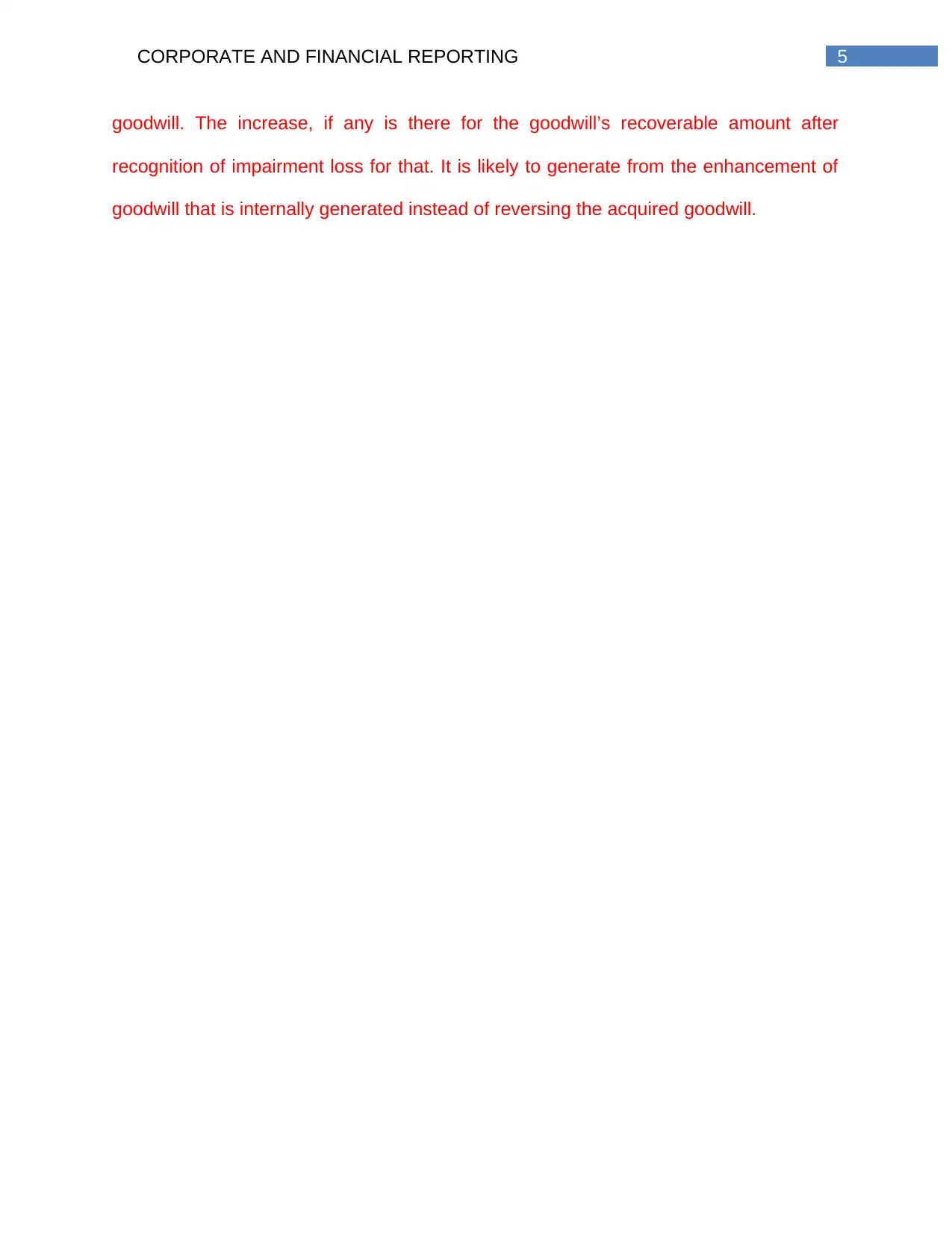
5CORPORATE AND FINANCIAL REPORTING
goodwill. The increase, if any is there for the goodwill’s recoverable amount after
recognition of impairment loss for that. It is likely to generate from the enhancement of
goodwill that is internally generated instead of reversing the acquired goodwill.
goodwill. The increase, if any is there for the goodwill’s recoverable amount after
recognition of impairment loss for that. It is likely to generate from the enhancement of
goodwill that is internally generated instead of reversing the acquired goodwill.
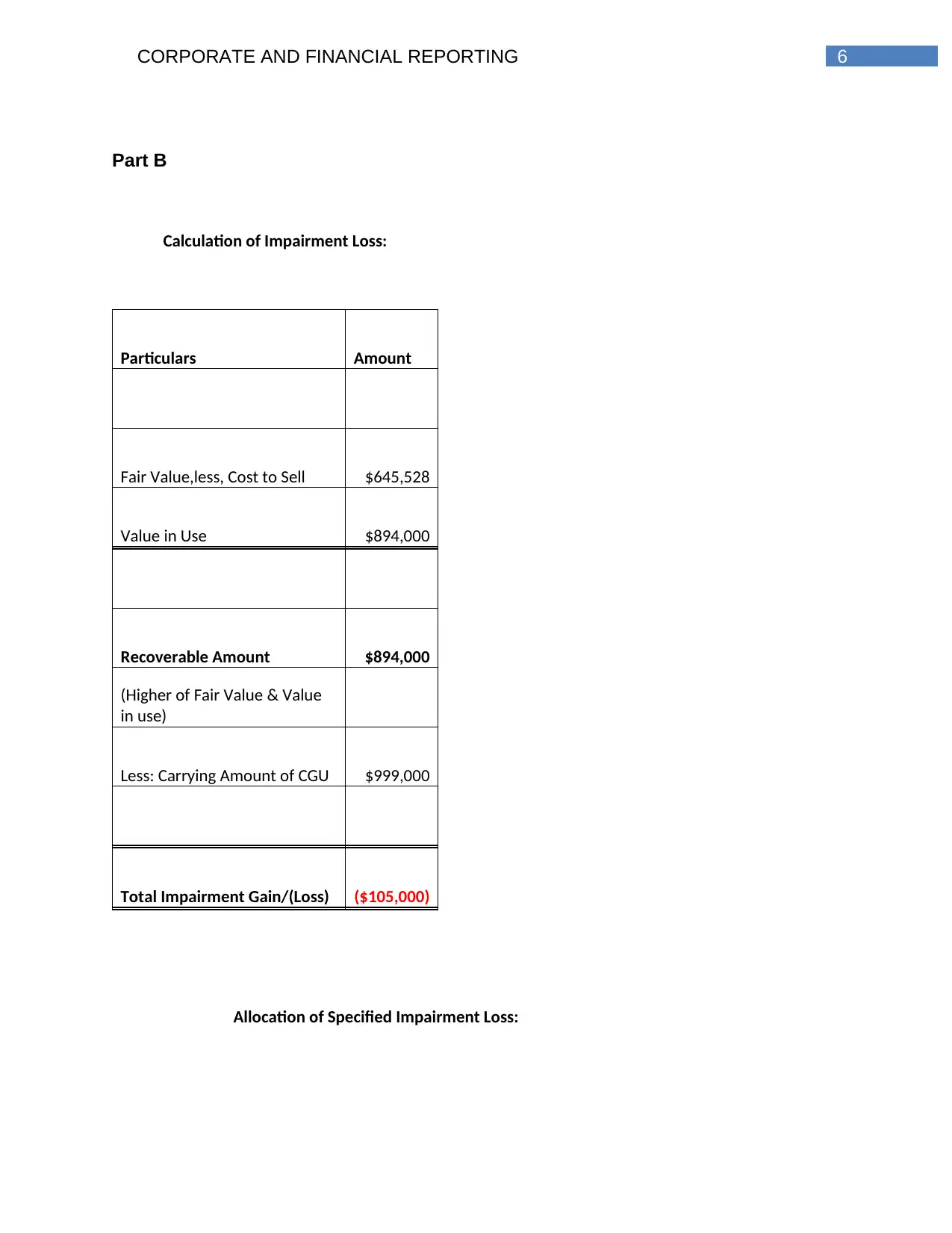
6CORPORATE AND FINANCIAL REPORTING
Part B
Calculation of Impairment Loss:
Particulars Amount
Fair Value,less, Cost to Sell $645,528
Value in Use $894,000
Recoverable Amount $894,000
(Higher of Fair Value & Value
in use)
Less: Carrying Amount of CGU $999,000
Total Impairment Gain/(Loss) ($105,000)
Allocation of Specified Impairment Loss:
Part B
Calculation of Impairment Loss:
Particulars Amount
Fair Value,less, Cost to Sell $645,528
Value in Use $894,000
Recoverable Amount $894,000
(Higher of Fair Value & Value
in use)
Less: Carrying Amount of CGU $999,000
Total Impairment Gain/(Loss) ($105,000)
Allocation of Specified Impairment Loss:
Paraphrase This Document
Need a fresh take? Get an instant paraphrase of this document with our AI Paraphraser
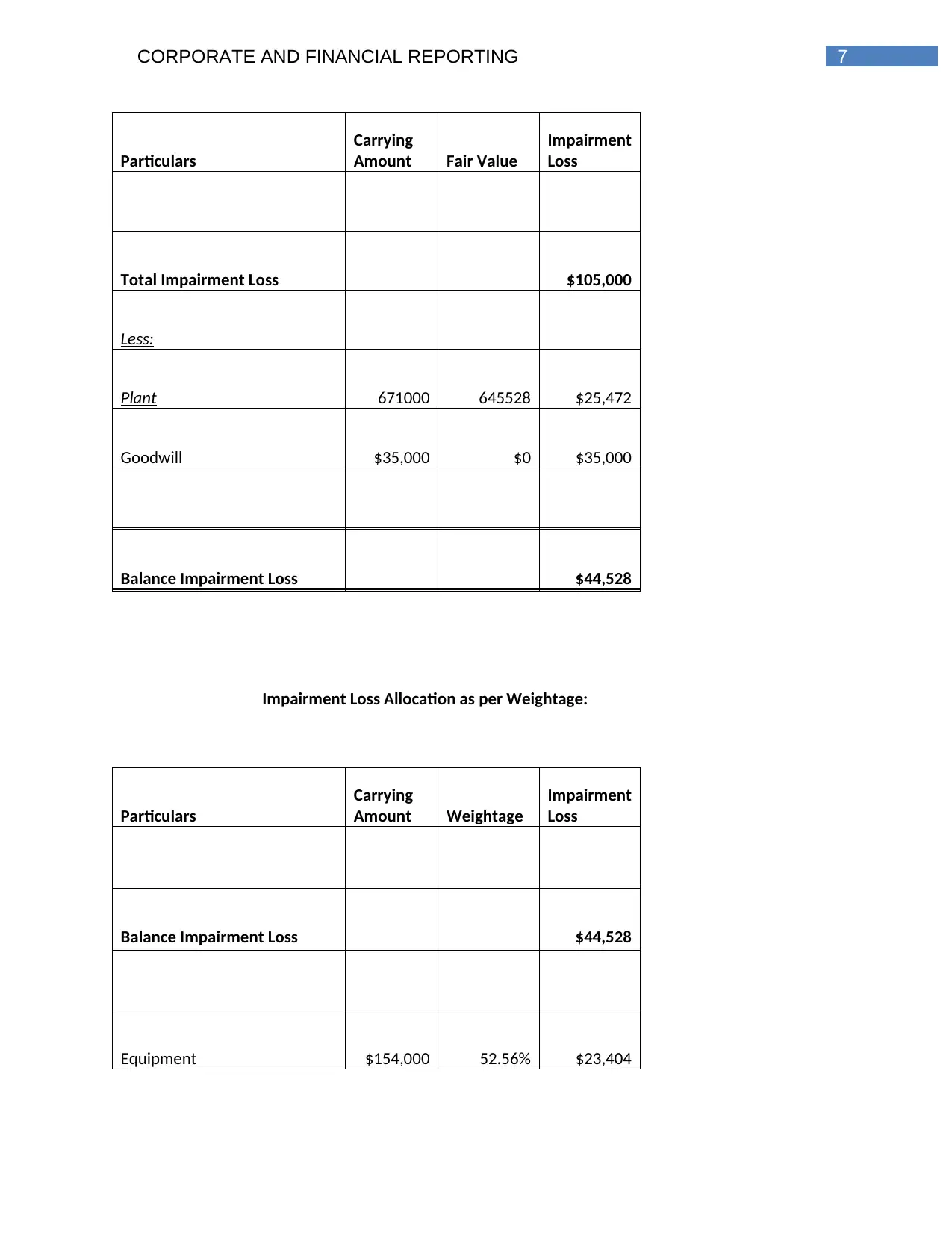
7CORPORATE AND FINANCIAL REPORTING
Particulars
Carrying
Amount Fair Value
Impairment
Loss
Total Impairment Loss $105,000
Less:
Plant 671000 645528 $25,472
Goodwill $35,000 $0 $35,000
Balance Impairment Loss $44,528
Impairment Loss Allocation as per Weightage:
Particulars
Carrying
Amount Weightage
Impairment
Loss
Balance Impairment Loss $44,528
Equipment $154,000 52.56% $23,404
Particulars
Carrying
Amount Fair Value
Impairment
Loss
Total Impairment Loss $105,000
Less:
Plant 671000 645528 $25,472
Goodwill $35,000 $0 $35,000
Balance Impairment Loss $44,528
Impairment Loss Allocation as per Weightage:
Particulars
Carrying
Amount Weightage
Impairment
Loss
Balance Impairment Loss $44,528
Equipment $154,000 52.56% $23,404
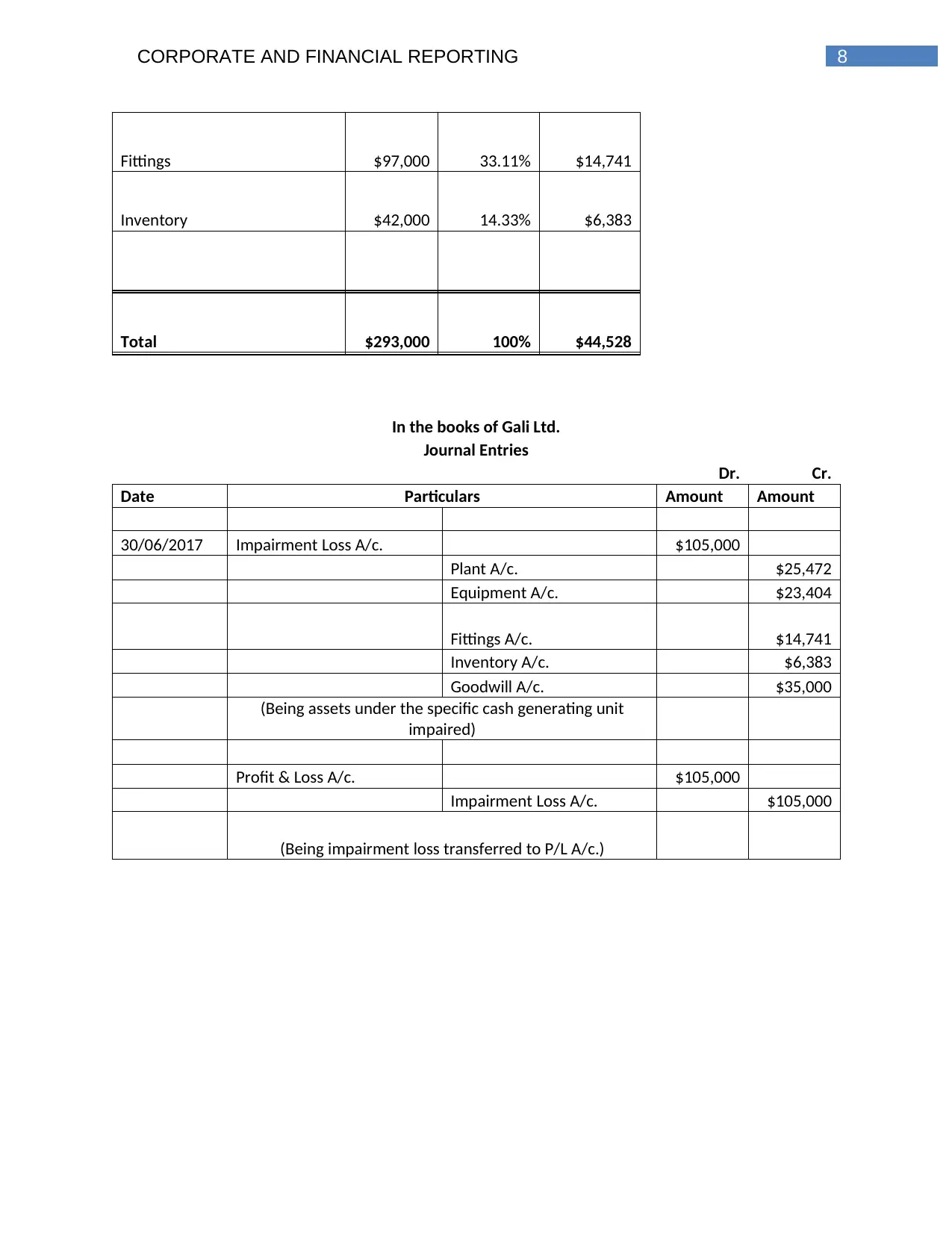
8CORPORATE AND FINANCIAL REPORTING
Fittings $97,000 33.11% $14,741
Inventory $42,000 14.33% $6,383
Total $293,000 100% $44,528
In the books of Gali Ltd.
Journal Entries
Dr. Cr.
Date Particulars Amount Amount
30/06/2017 Impairment Loss A/c. $105,000
Plant A/c. $25,472
Equipment A/c. $23,404
Fittings A/c. $14,741
Inventory A/c. $6,383
Goodwill A/c. $35,000
(Being assets under the specific cash generating unit
impaired)
Profit & Loss A/c. $105,000
Impairment Loss A/c. $105,000
(Being impairment loss transferred to P/L A/c.)
Fittings $97,000 33.11% $14,741
Inventory $42,000 14.33% $6,383
Total $293,000 100% $44,528
In the books of Gali Ltd.
Journal Entries
Dr. Cr.
Date Particulars Amount Amount
30/06/2017 Impairment Loss A/c. $105,000
Plant A/c. $25,472
Equipment A/c. $23,404
Fittings A/c. $14,741
Inventory A/c. $6,383
Goodwill A/c. $35,000
(Being assets under the specific cash generating unit
impaired)
Profit & Loss A/c. $105,000
Impairment Loss A/c. $105,000
(Being impairment loss transferred to P/L A/c.)
1 out of 9
Related Documents
Your All-in-One AI-Powered Toolkit for Academic Success.
+13062052269
info@desklib.com
Available 24*7 on WhatsApp / Email
![[object Object]](/_next/static/media/star-bottom.7253800d.svg)
Unlock your academic potential
© 2024 | Zucol Services PVT LTD | All rights reserved.





